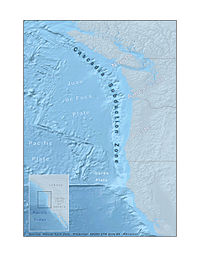
Photo from wikipedia
Forecasting earthquake and tsunami hazards along the southern Cascadia subduction zone is complicated by uncertainties in the amount of megathrust fault slip during past ruptures. Here, we estimate slip on… Click to show full abstract
Forecasting earthquake and tsunami hazards along the southern Cascadia subduction zone is complicated by uncertainties in the amount of megathrust fault slip during past ruptures. Here, we estimate slip on hypothetical ruptures of the southern part of the megathrust through comparisons of late Holocene Cascadia earthquake histories derived from tsunami deposits on land and marine turbidites offshore. Bradley Lake in southern Oregon lies ~600 m landward of the shoreline and contains deposits from 12 tsunamis in the past 4600 years. Tsunami simulations that overtop the 6-m-high lake outlet, generated by ruptures with most slip south of Cape Blanco, require release of at least as much strain on the megathrust as would accumulate in 430–640 years (>15–22 m). Such high slip is inconsistent with global seismic data for a rupture ~300-km long and slip deficits over the past ~4700 years on the southern Cascadia subduction zone. Assuming slip deficits accumulated during the time intervals between marine turbidites, up to 8 of 12 tsunami inundations at the lake are predicted from a marine core site 170 km north of the lake (at Hydrate Ridge) compared to 4 of 12 when using a core site ~80 km south (at Rogue Apron). Longer time intervals between turbidites at Hydrate Ridge imply larger slip deficits compared to Rogue Apron. The different inundations predicted by the two records suggest that Hydrate Ridge records subduction ruptures that extend past both Rogue Apron and Bradley Lake. We also show how turbidite-based estimates of CSZ rupture length relate to tsunami source scenarios for probabilistic tsunami hazard assessments consistent with lake inundations over the last ~4600 years.
Journal Title: Natural Hazards
Year Published: 2017
Link to full text (if available)
Share on Social Media: Sign Up to like & get
recommendations!